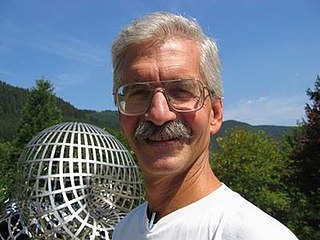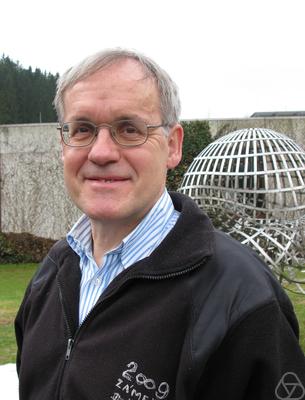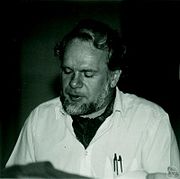In mathematics, the term "almost all" means "all but a negligible quantity". More precisely, if is a set, "almost all elements of " means "all elements of but those in a negligible subset of ". The meaning of "negligible" depends on the mathematical context; for instance, it can mean finite, countable, or null.
In mathematics, the ascending chain condition (ACC) and descending chain condition (DCC) are finiteness properties satisfied by some algebraic structures, most importantly ideals in certain commutative rings. These conditions played an important role in the development of the structure theory of commutative rings in the works of David Hilbert, Emmy Noether, and Emil Artin. The conditions themselves can be stated in an abstract form, so that they make sense for any partially ordered set. This point of view is useful in abstract algebraic dimension theory due to Gabriel and Rentschler.

David Bryant Mumford is an American mathematician known for his work in algebraic geometry and then for research into vision and pattern theory. He won the Fields Medal and was a MacArthur Fellow. In 2010 he was awarded the National Medal of Science. He is currently a University Professor Emeritus in the Division of Applied Mathematics at Brown University.
In mathematics, a formal group law is a formal power series behaving as if it were the product of a Lie group. They were introduced by S. Bochner. The term formal group sometimes means the same as formal group law, and sometimes means one of several generalizations. Formal groups are intermediate between Lie groups and Lie algebras. They are used in algebraic number theory and algebraic topology.
The Centrum Wiskunde & Informatica is a research centre in the field of mathematics and theoretical computer science. It is part of the institutes organization of the Dutch Research Council (NWO) and is located at the Amsterdam Science Park. This institute is famous as the creation site of the programming language Python. It was a founding member of the European Research Consortium for Informatics and Mathematics (ERCIM).
In mathematics, a zero-dimensional topological space is a topological space that has dimension zero with respect to one of several inequivalent notions of assigning a dimension to a given topological space. A graphical illustration of a zero-dimensional space is a point.

Nigel James Hitchin FRS is a British mathematician working in the fields of differential geometry, gauge theory, algebraic geometry, and mathematical physics. He is a Professor Emeritus of Mathematics at the University of Oxford.

Nicholas Michael Katz is an American mathematician, working in arithmetic geometry, particularly on p-adic methods, monodromy and moduli problems, and number theory. He is currently a professor of Mathematics at Princeton University and an editor of the journal Annals of Mathematics.
Johannes Aldert "Jan" Bergstra is a Dutch computer scientist. His work has focused on logic and the theoretical foundations of software engineering, especially on formal methods for system design. He is best known as an expert on algebraic methods for the specification of data and computational processes in general.
Algebraic modeling languages (AML) are high-level computer programming languages for describing and solving high complexity problems for large scale mathematical computation. One particular advantage of some algebraic modeling languages like AIMMS, AMPL, GAMS, Gekko, MathProg, Mosel, and OPL is the similarity of their syntax to the mathematical notation of optimization problems. This allows for a very concise and readable definition of problems in the domain of optimization, which is supported by certain language elements like sets, indices, algebraic expressions, powerful sparse index and data handling variables, constraints with arbitrary names. The algebraic formulation of a model does not contain any hints how to process it.
In mathematics and physics, a nonlinear partial differential equation is a partial differential equation with nonlinear terms. They describe many different physical systems, ranging from gravitation to fluid dynamics, and have been used in mathematics to solve problems such as the Poincaré conjecture and the Calabi conjecture. They are difficult to study: almost no general techniques exist that work for all such equations, and usually each individual equation has to be studied as a separate problem.
Jan Hendrik van Schuppen is a Dutch mathematician and Professor at the Department of Mathematics of the Vrije Universiteit, known for his contributions in the field of systems theory, particularly on control theory and system identification, on probability, and on a number of related practical applications.
In mathematics, especially in the area of abstract algebra known as module theory, a principal indecomposable module has many important relations to the study of a ring's modules, especially its simple modules, projective modules, and indecomposable modules.

Paul Michael Béla Vitányi is a Dutch computer scientist, Professor of Computer Science at the University of Amsterdam and researcher at the Dutch Centrum Wiskunde & Informatica.

Alexander (Lex) Schrijver is a Dutch mathematician and computer scientist, a professor of discrete mathematics and optimization at the University of Amsterdam and a fellow at the Centrum Wiskunde & Informatica in Amsterdam. Since 1993 he has been co-editor in chief of the journal Combinatorica.
In algebra, a Taft Hopf algebra is a Hopf algebra introduced by Earl Taft that is neither commutative nor cocommutative and has an antipode of large even order.
Carlos Tschudi Simpson is an American mathematician, specializing in algebraic geometry.

Claus Michael Ringel is a German mathematician, specializing in algebra.

Frans Oort is a Dutch mathematician who specializes in algebraic geometry.

In mathematics, a Siegel modular variety or Siegel moduli space is an algebraic variety that parametrizes certain types of abelian varieties of a fixed dimension. More precisely, Siegel modular varieties are the moduli spaces of principally polarized abelian varieties of a fixed dimension. They are named after Carl Ludwig Siegel, the 20th-century German number theorist who introduced the varieties in 1943.








